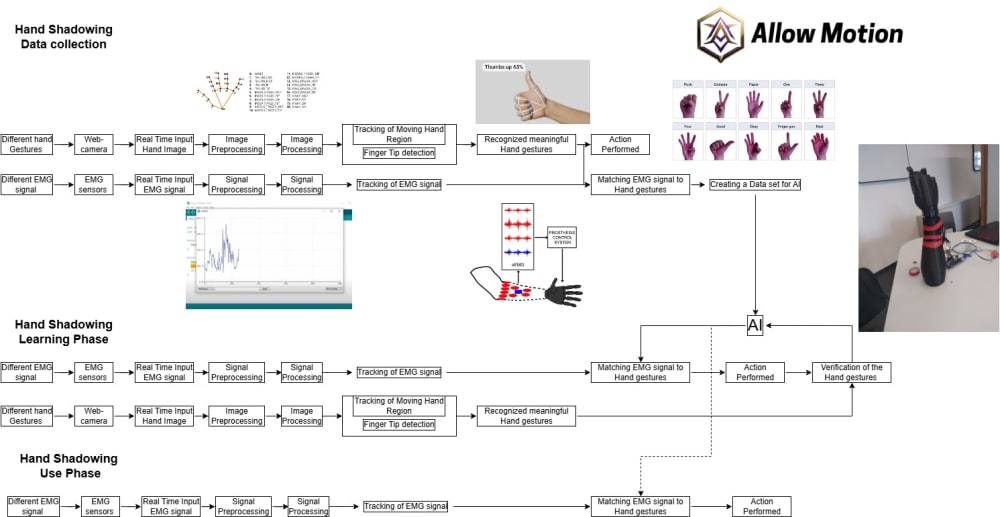Allow Motion revolutionizes upper-limb prosthetics with a modular, 3D-printed myoelectric system that adapts to any amputation level—from partial hand to full arm—via customizable, lightweight designs. By integrating AI-driven gesture recognition and 3D scanning of residual limbs, it eliminates the need for invasive surgery or pre-programmed patterns, enabling seamless human-machine interaction.
The Problem
- Prohibitively Expensive: Traditional prosthetics cost €20,000–€100,000, making them inaccessible to 95% of patients
- Poor Usability: 50% of amputees abandon prosthetics due to discomfort, rigid designs, and lack of intuitive control
- Long Wait Times: Months-long delays for custom fittings.
Our Solutions
- Affordability: 60% cheaper than traditional prosthetics.
- Lightweight Design: 50% lighter using 3D-printed modular components.
- Advanced Control: AI-driven myoelectric systems with self-learning capabilities—no pre-programmed patterns or invasive surgery.
- Custom Fit: 3D scans of residual limbs ensure perfect ergonomics.
Key Innovations:
Modular Design:
One system scales to replace hand, hand + forearm, or full arm using interchangeable 3D-printed components.
Custom-fit via 3D scans of residual limbs for optimal comfort and mobility.
AI Embodiment:
- Self-learning myoelectric control: Uses EMG sensors + machine learning to interpret muscle signals in real time—no tedious pattern training.
- Computer vision assist (optional): Cameras validate gestures for enhanced accuracy (e.g., distinguishing a "grip" from a "wave").
Accessibility:
- Non-invasive: Avoids neural implants or complex surgeries.
- Affordability: 60% cheaper than traditional prosthetics.
- Lightweight Design: 50% lighter using 3D-printed modular components.
- Advanced Control: AI-driven myoelectric systems with self-learning capabilities—no pre-programmed patterns or invasive surgery.
- Custom Fit: 3D scans of residual limbs ensure perfect ergonomics.
Applications:
- Medical: Affordable, adaptive prosthetics for amputees.
- Research: Platform for AI-human interaction studies.
Feasibility:
- Production: On-demand 3D printing lowers costs (~60% cheaper than commercial prosthetics).
- Software: Open-source AI model (Python/TensorFlow) for community-driven improvements.
Market Potential:
- 2.1 million upper-limb amputees globally (WHO).
- $6.9B prosthetic market by 2028 (Grand View Research).
- Already backed by university, 17 O&P, hospitals worldwide.
Like this entry?
-
About the Entrant
- Name:Delporte Joachim
- Type of entry:individual
- Software used for this entry:Allow Motion's homemade software
- Patent status:pending


